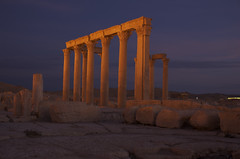I'm somewhat sorry for this post. No, make this really sorry. Sorry, sorry, sorry. But rest assured, if you are getting too much of the dull old art world from me, I'm also boring myself to death writing it. However, after coming across a spectacular and most unexpected exhibition this weekend, I can't refrain from covering the same old topic. Damien Hirst has enlisted the auction house Sotheby's to run a huge yard sale.
The sale is big enough to merit the cover of the most recent Time magazine and a seven-page article inside where Hirst is plugged like a pierced rubber dinghy about to go under. – Hey, wait a minute. How come I'm referring to Time? This rag is not normally on my reading list. Well, ever since moving in, I've been finding a copy of Time on my doorstep every week. Someone must be faithfully renewing his subscription without ever noticing that no issue ever arrives. Thank you, Marouf.
Of course I don't need Time to tell me who Damien Hirst is. I saw his bisected bovine preparation, presented in four huge, brilliantly clear glass tanks at the Turner Prize retrospective at the Tate last fall, and I was mighty impressed with it.
It was a first impression, and it didn't last. Once the novelty of a pickled farm animal in an immaculate tank has faded what remains is a painful lack of creativity and artistic spirit, albeit highly sellable. This guy has assistants churning out canvasses day and night that roughly follow Hirst's direction but need not necessarily have had any input from him. While he's sitting on his farm in Devon or in his suite at Claridge's in London, the assembly line never stops, popping out nearly identical pieces by the hour.
On Sunday, I went to Sotheby's. As always before an auction, a public viewing was held, an event that would be a major exhibition in any other context but scarcely merits a footnote here. 223 of Damien's Hirst's pieces, all manufactured in 2008, were assembled and luridly longed for attention. Colorful dots were on dozens of images, real butterflies and fakes diamonds on dozens more.
There were about ten more tanks with various preserved animals or parts thereof. One, a white dove, was truly stunning and made the exhibition worth my time. The bird hovered near the top of the upright tank, its wings stretched, as if it were about to fly off towards a better world. The liquid inside this tank was highly transparent and acted like a lens, clarifying and magnifying the object inside. The dove seemed to float, held by nothing, in complete disregard of the laws of physics. Only close inspection revealed the presence of the finest of pins that attached the tail feathers via a hidden steel skeleton to a nearly invisible glass plate inside the tank.
Beyond the technical finesse of the taxidermies, the exhibition was a tepid, but the amount of work invited contemplation. Damien Hirst is unashamedly commercial. It seems to me that, every time he's creating something, he's upping the ante and climbing one step further on the ladder of spending craziness. Art this is certainly not. Sotheby's is in New Bond St., right next to Prada and down the road from Louis Vuitton and other boutiques. Damien Hirst fits right in. He is a purveyor of luxury goods. Just as much as stitching a crocodile to a cheap t-shirt puts it on the top shelf, so does the Hirst signature and seal elevate the value of paper and paint.
For him, the challenge now is not to be creative but to distribute his different products in a way that the market can support. Make a hundred spot paintings to many, and you won't find enough billionaires stupid enough to buy into the craze. The same goes for animals tanks, butterflies glued to cardboard or medical-cabinet installations.
There was hardly any creativity in the exhibited works. Initially, I was imagining that the auction was a devious ploy by Damien Hirst to expose the utter foolishness of the arts establishment, a biting criticism of art following money, but I've come to the realization that it was just a ploy to get as many gullible suckers as possible to spend as much money as possible.
That's a valid goal. Just don't call it art.

No comments:
Post a Comment